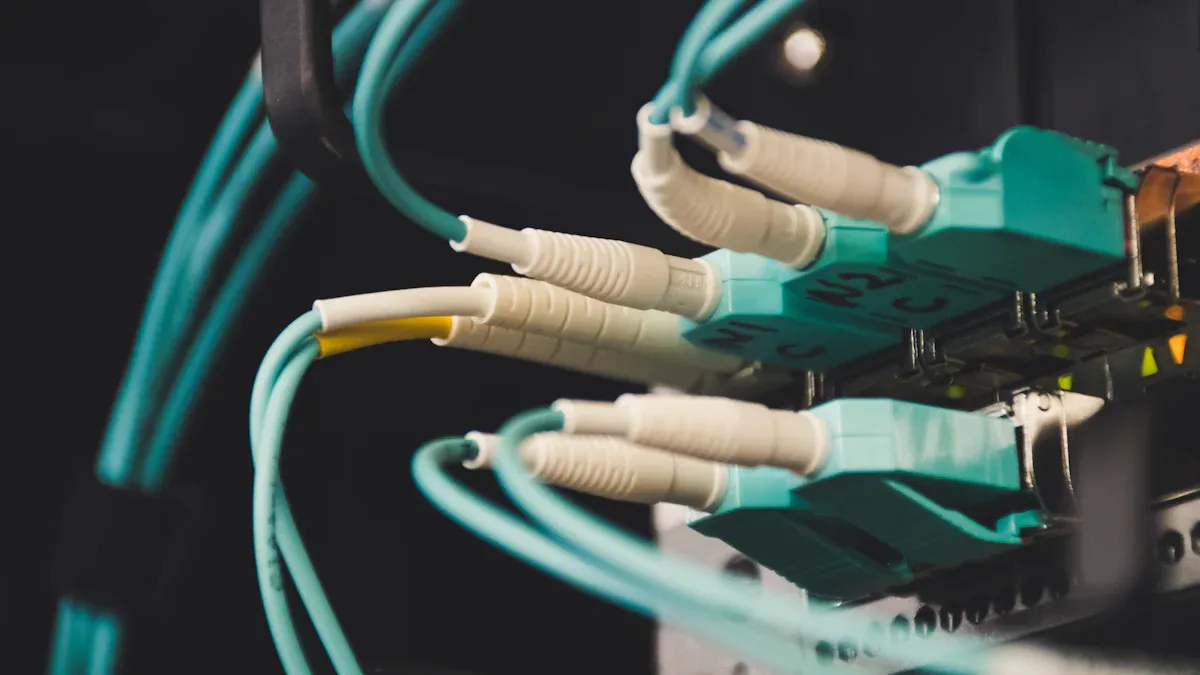Testing Telecom Rectifiers for Efficiency and Durability

Telecom rectifiers are important for running telecom systems. They change AC power into DC power to work smoothly. Some rectifiers can be 96% efficient in mains mode. They also stay 94% efficient when working as inverters. This great performance saves energy and ensures steady power for telecom use.
Key Takeaways
Checking telecom rectifiers keeps power steady, cutting downtime and boosting reliability.
Efficient rectifiers use less energy and save money, with some working at 98.5% efficiency.
Testing and stress checks make rectifiers last longer, needing fewer fixes and costing less to maintain.
Importance of Testing Telecom Rectifiers
Keeping Power Steady
Testing telecom rectifiers helps keep power steady for systems. These devices change AC power into DC power smoothly. Without testing, rectifiers might fail with changing voltage or current. Failures can cause expensive downtime for telecom networks. Tools like real-time diagnostics find problems early. Early fixes make systems more reliable and reduce interruptions.
Metric | Description |
|---|---|
Compatibility | Makes sure rectifiers fit with systems, avoiding costly issues. |
Advanced Monitoring | Finds problems early using real-time tools, saving resources. |
Saving Energy
Energy-saving is key in designing telecom rectifiers. Testing ensures rectifiers work well and waste less energy. Some modern rectifiers are up to 98.5% efficient. This lowers costs and saves power. Testing also checks new tech like 12-pulse rectifiers. These can cut energy loss by 30%. Better efficiency saves energy and supports greener telecom systems.
Evidence Description | Impact on Energy Efficiency |
|---|---|
High-efficiency rectifiers reduce energy loss by up to 30%. | Shows how 12-pulse rectifiers improve efficiency. |
Making Rectifiers Last Longer
Testing helps rectifiers handle tough conditions. Stress tests find weak spots and improve durability. Regular checks and testing make rectifiers last longer. This means fewer replacements, saving money and time. Testing also keeps rectifiers reliable in changing environments.
Metric | Description |
|---|---|
Maintenance Considerations | Regular testing and care make rectifiers last longer and avoid failures. |
Key Parameters in Testing Telecom Rectifiers
Efficiency and Power Conversion Metrics
Efficiency shows how well rectifiers change AC to DC power. It also checks if energy loss is low during conversion. High-efficiency rectifiers save money and support eco-friendly telecom systems. Tests measure things like peak efficiency, harmonic distortion, and power density. These checks ensure rectifiers work well under different loads.
Parameter | Value |
|---|---|
Peak Efficiency | 96.3% |
Total Harmonic Distortion (THD) | < 5% at full load |
Output Power | Up to 40 W/inch³ |
Input Voltage Range | Universal mains input range |
Rectifiers with 95% or higher efficiency are great for big setups. They save energy and make less heat, improving system reliability. Power factor correction (PFC) tech helps by lowering distortion and boosting power use.
Efficiency Rating Range | Description |
|---|---|
90% to 92% | Standard models balance cost and performance. |
92% to 94% | High-efficiency models save energy and work better. |
95% and Above | Ultra-efficient models save costs for large setups. |
Thermal Management and Performance
Heat control is key for keeping rectifiers working well. Too much heat can damage parts and lower efficiency. Tests check how rectifiers handle heat with cooling systems and materials. High-efficiency rectifiers make less heat, needing simpler cooling setups. Thermal tests ensure stable operation even under heavy loads. Rectifiers with wide temperature ranges work well in tough environments.
Specification | Value |
|---|---|
Operating Temperature Range | -40°C to +65°C |
Efficiency | Up to 96% |
Reliability Under Stress and Environmental Conditions
Stress tests check if rectifiers can handle tough conditions. These tests mimic real-world challenges like high voltage, current surges, and temperature changes. They find weak spots and help improve durability.
Stress Mode | Description | Impact on Device Lifetime |
|---|---|---|
Voltage | High voltage stress applied | Can cause internal failures. |
Current | High current density | May lead to wear and tear. |
Temperature | Varying temperatures | Affects long-term reliability. |
Humidity | Exposure to humidity | Can cause rust or damage. |
Rectifiers are built to last 15 years with very few failures. Advanced tests ensure they meet strict standards. Reliable rectifiers reduce downtime and save maintenance costs.
Compliance with Industry Standards
Industry rules ensure rectifiers are safe and work well. Tests confirm rectifiers meet energy, safety, and environmental standards. This makes them fit for telecom networks worldwide.
Region | Regulatory Body/Initiative | Compliance Impact |
|---|---|---|
North America | Requires rectifiers to meet energy-saving rules. | |
Europe | EcoDesign Directive | Sets energy limits, ensuring most new setups comply. |
Asia-Pacific | Various initiatives | Pushes for energy-efficient rectifiers through local rules. |
Meeting standards like NEBS Level 3 proves rectifiers work in harsh places. Certifications like CE Mark and UL Recognized show they are safe and high-quality. Following these rules ensures rectifiers perform well globally.
Testing Methods for Telecom Rectifiers

Functional Testing for Core Operations
Functional testing checks if rectifiers change AC power to DC power well. It tests if the rectifier keeps voltage and current steady under different loads. This testing ensures the rectifier works accurately and handles input changes. It also checks if it fits with telecom systems properly.
The test looks at how the rectifier works with other parts. For example, it checks if it handles sudden power changes without failing. Finding problems early helps improve the rectifier's performance. This ensures it works smoothly in real-world telecom setups.
Thermal Evaluation for Heat Dissipation
Managing heat is important for rectifiers to work well and last long. Thermal tests check how well the rectifier cools itself during use. Special tools like simulations predict heat levels and test cooling designs. These tests compare expected results with real heat data to ensure proper cooling.
High heat can harm rectifiers and lower their performance. Adjusting cooling fins and airflow keeps temperatures safe. This helps rectifiers work well even when heavily used. Good heat control stops overheating and makes rectifiers last longer, saving money on repairs.
Stress Testing for Peak Load Performance
Stress tests check how rectifiers handle tough conditions. These tests simulate high voltage, current surges, and temperature changes. They find weak spots in the design and make rectifiers stronger.
For instance, high current tests show where parts might wear out. Temperature and humidity tests ensure rectifiers work in all environments. Stress testing proves rectifiers are strong enough for modern telecom needs.
Tools and Technologies for Advanced Testing
Modern tools make testing easier and more accurate. Automated systems measure efficiency, heat control, and reliability. These tools give quick data to find and fix problems fast.
Heat cameras and sensors show how heat spreads on the rectifier. Power analyzers check energy conversion and distortion levels. Using these tools improves testing and ensures rectifiers meet industry standards.
Challenges in Testing Telecom Rectifiers
Handling Different Environments
Telecom rectifiers work in many places, from cold to humid areas. Tests check if they stay efficient and reliable in tough conditions. Extreme temperature changes, high humidity, and dust can cause problems. Thermal cycling tests mimic fast temperature shifts to find weak spots. Humidity tests show how moisture affects parts inside. These tests make sure rectifiers work well, even in hard environments.
Testing for Power and Growth
Big telecom systems need rectifiers to handle changing power needs. Tests ensure rectifiers deliver power efficiently without losing performance. Special controls adjust power based on demand for better results. Strong designs prevent failures and keep systems running smoothly. Below is a table showing key points for testing power and growth:
Metric | ESTEL Delta Rectifier Models | Description |
|---|---|---|
Efficiency | Above 95% | Saves energy and lowers costs. |
Load Handling | Advanced control mechanisms | Matches power delivery to demand for top performance. |
Reliability | Fault-tolerant designs | Prevents downtime and keeps systems reliable. |
These features show how modern rectifiers meet telecom needs while staying efficient and dependable.
Keeping Costs Low but Accurate
Testing rectifiers can cost a lot, but skipping tests risks failures. Automated tools help save money while staying precise. Tools like power analyzers and heat cameras give quick and accurate results. Using smart testing methods ensures rectifiers meet standards without spending too much. This helps telecom systems stay reliable and saves money over time.
Real-World Uses of Telecom Rectifier Testing
Easy Fit into Telecom Systems
Testing telecom rectifiers helps them work well in networks. It checks if they match system needs and perform properly. For example, one project used 48V rectifiers in 54 places. These rectifiers had power ranges from 7.5kW to 60kW. The work included planning, removing old parts, installing, testing, and starting up. Tools like Flatpack2 HE rectifiers and FIAMM batteries made power delivery steady and efficient. This shows how testing improves system setup and keeps networks reliable.
Helping Systems Run Better
Testing makes sure rectifiers work efficiently to meet goals. Efficient rectifiers waste less energy, saving money and helping the planet. Telecom companies spend less and lower their environmental impact. Tests also check if rectifiers keep voltage and current steady. This ensures power stays consistent even with changing loads. By using energy wisely, telecom systems can perform well and meet efficiency targets.
Reducing Breakdowns and Repair Costs
Network downtime costs money and upsets customers. Testing finds problems early to avoid these issues. Stress tests copy real-world challenges like high voltage or power surges. These tests ensure rectifiers can handle tough situations. Reliable rectifiers need fewer repairs, saving money over time. Good testing keeps networks running smoothly and lowers repair costs. This improves customer happiness and system reliability.
Testing is important to make sure telecom rectifiers work well. It checks durability and energy use for better system fit. Good testing lowers risks and improves reliability. This helps manufacturers and users by boosting long-term performance.
FAQ
Why do we test telecom rectifiers?
Testing checks if rectifiers work well and meet rules. It proves they can handle real-world use without problems.
How does stress testing help rectifiers?
Stress tests show weak spots by copying tough conditions. This makes rectifiers stronger and ready for hard situations.
Why is heat control important in testing?
Heat control stops parts from getting too hot and breaking. Testing ensures rectifiers stay cool and work well for a long time.
See Also
Ensuring Consistent Power Supply for Telecom Equipment
Key Features of Power Supplies for Telecom Systems
Calculating Power Systems and Battery Needs for Telecom Cabinets
A Complete Risk Assessment Guide for Telecom Cabinet Batteries
CALL US DIRECTLY
86-13752765943
3A-8, SHUIWAN 1979 SQUARE (PHASE II), NO.111, TAIZI ROAD,SHUIWAN COMMUNITY, ZHAOSHANG STREET, NANSHAN DISTRICT, SHENZHEN, GUANGDONG, CHINA

